| Author | Message | ||
Rick_a |
Waiting on a parts kit for the lower half.  20140303_100646 by Slick_Rick77, on Flickr  20140303_100716 by Slick_Rick77, on Flickr The wife will be intercepting that parts shipment and a hard time will likely ensue. | ||
Torquehd |
is that where you're going to leave the forward grip? have you tried shooting with a pistol grip as far forward on the rail as possible? for most people, the closer your hand is to the front of the barrel, the more control you have, especially while shooting and moving at the same time. is that a 10"? | ||
Rick_a |
It's a 7." That's where it feels right to me. The balance point is just in front of the mag well. I'll use a forward grip for quick transitions with a 16" plus barreled gun. For the short stuff it doesn't make a difference to me. | ||
Slaughter |
9mm? | ||
D_adams |
I need another upper to go with the RRA lower I have. Bought all Magpul pink furniture to dress it up for the girls, they have no idea I'm building it. Still deciding on which upper to go with though.     (Message edited by d_adams on March 04, 2014) | ||
Teeps |
Nice, but we aren't allowed to own rifles like that in calif. | ||
D_adams |
^ move? | ||
Rick_a |
They're pistols...and yes you can: http://www.calguns.net/calgunforum/showthread.php? t=390460 Got it done the other day:  20140306_111747 by Slick_Rick77, on Flickr 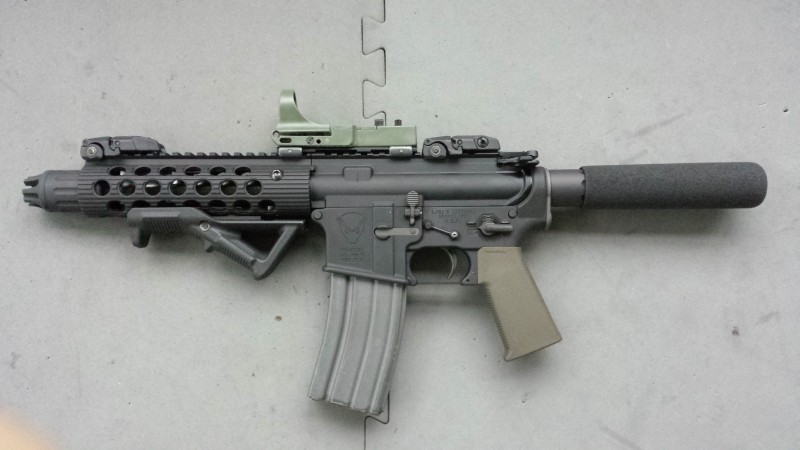 20140306_111715 by Slick_Rick77, on Flickr 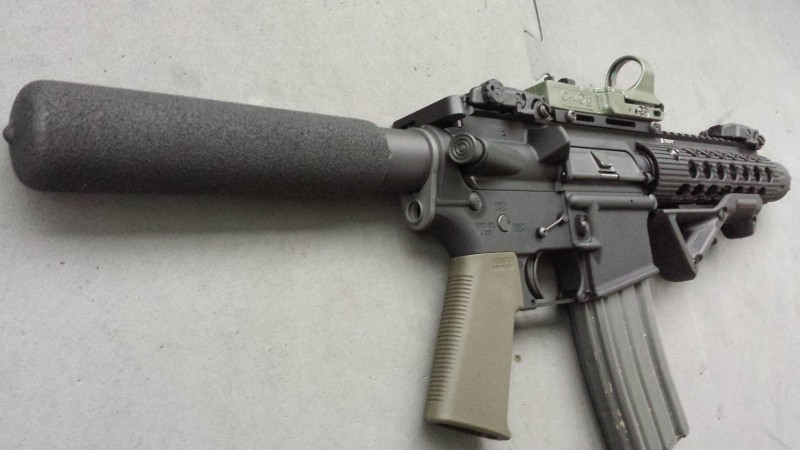 20140306_111807 by Slick_Rick77, on Flickr  20140306_111829 by Slick_Rick77, on Flickr 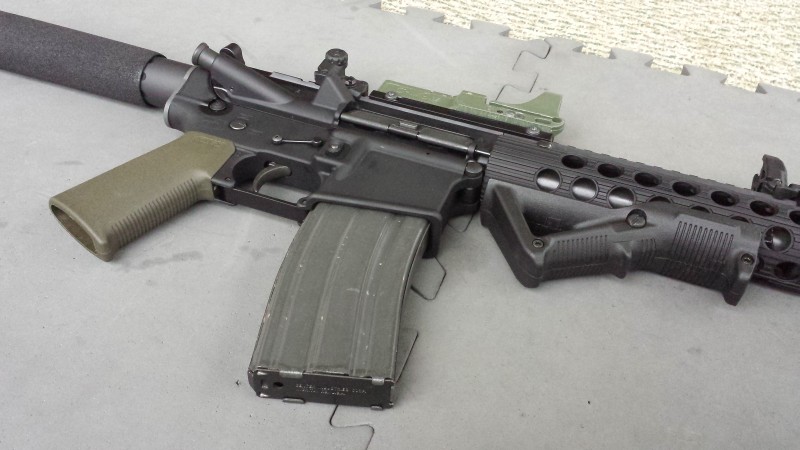 20140306_111933 by Slick_Rick77, on Flickr 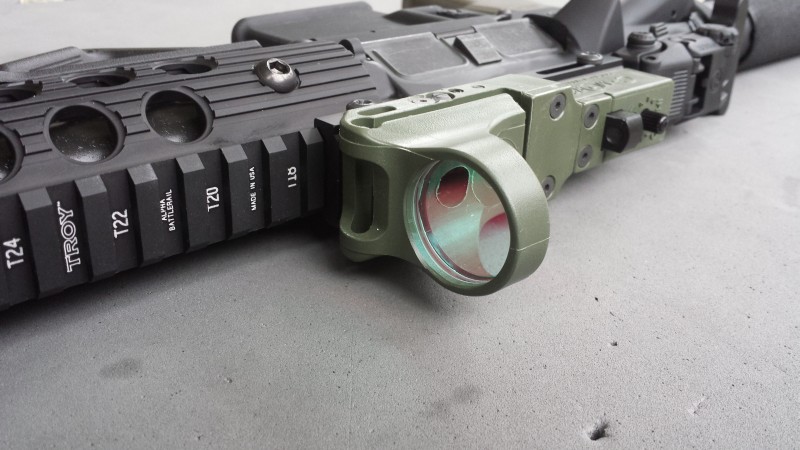 20140306_121007 by Slick_Rick77, on Flickr 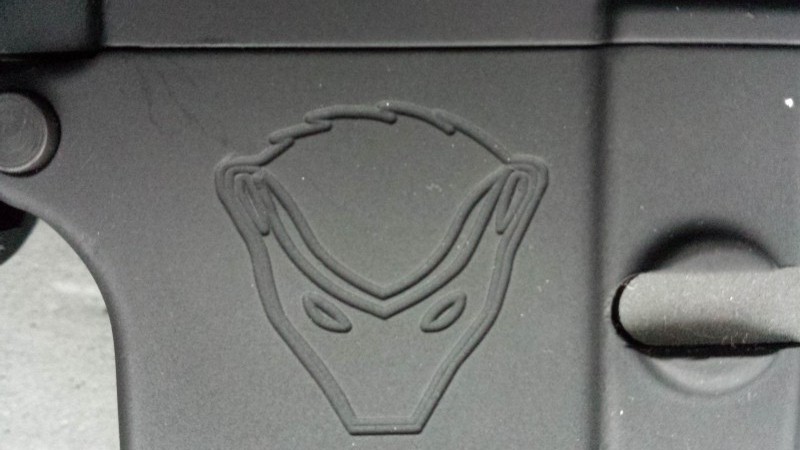 20140306_112103 by Slick_Rick77, on Flickr In the "honey badger don't care" theme, the selector is marked safe, fire, and "don't give a s**t. | ||
Slaughter |
I bet that beast is BLINDING at night! (but FUN!) | ||
Ourdee |
I want to build one with a 10" barrel like the CAR I used to carry. | ||
Ourdee |
Dean, Guy in the gun store tried to show my wife a pink gun last week. He's lucky she didn't puke on his counter. She can't stand pink guns. Ritt dye will probably fix those. I've had success with it in the past.  | ||
Gregtonn |
"Extra grooves, holes and other debris pockets on a weapon are like chrome on a Hog only worse."_Greg Tonn Just my opinion. I don't like "show guns". G (Message edited by Gregtonn on March 07, 2014) | ||
Rick_a |
The "extra grooves and holes" on aluminum free float tubes/quad rails are to maximize grip, lighten weight and dissipate heat. In this case the forend was used as a platform for the AFG, to maximize the sight radius, and allowing the use of a flip up front sight. Modern AR's in military service use KAC and DD rails. I doubt fashion is the primary reason for their use. Heck, even the standard hand guards are full of holes on the tops and bottoms and grooves along the rest. But hey, if you don't like it just say so  It's not built for show. The entire premise was a non-NFA, affordable PDW-style weapon using common parts. I go to the range with my guns carried on my back. This is much more transportable than any other rifle caliber firearm I have. With a 22lr conversion I can also do some back yard shooting. Being classified as a pistol also opens up other options compared to long guns in regards to use/transportation. (Message edited by Rick_a on March 08, 2014) | ||
Sifo |
But hey, if you don't like it just say so I don't like it!  If it works for you, then great! I just keep getting stuck on the idea of building a pistol with that buffer tube hanging out the back. It just seems awkward to me. Perhaps I might be able to see the light if you could arrange for me to shoot a bunch of rounds with Honey Badger selected though.  | ||
Sifo |
Nice gun BTW, but I do have a personal mental block in using the AR platform as a pistol. That could very well be my short coming though. | ||
Nillaice |
have you thought about adding a 'forearm brace'? | ||
Sifo |
Rick, Being totally serious here, what is it that you like most about this build over what could be purchased as an over the counter pistol? Is it just fun factor of the build? The idea of a .223 round in a self defense pistol? Do you see the buffer tube as a positive or negative thing? I'm still trying to get my head wrapped around this gun. I've also been thinking about .223 as a primary home defense round. The more I look at it, the more I like many attributes with the correct ammo. | ||
Torquehd |
As long as that upper can be mounted on a regular AR lower, I'm all for this gun. (or swap the buffer spring tube) (Message edited by torquehd on March 08, 2014) | ||
Thumper74 |
I've been itching for an AR pistol for a while. I wonder if I could do a piston AR15 pistol so I don't have to deal with the buffer tube. I have an unbuilt lower sitting around. I almost pulled the trigger on a Daniel Defense AR this week and swung some side work for a family friend who's going to trade me a nice AR to replace the engine in his truck. 'Free' AR! | ||
Rick_a |
What I like about the AR pistol configuration with a pistol buffer tube is the flexibility. Here's an example of how they can be utilized: This is mainly for fun/range/backyard use. It can be used in a more serious role but bullet selection is critical as standard ammunition will not fragment at such low velocities. Some types of expanding ammo will still work well. I actually built this one in a 10.5" barrel specifically for home use:  It's in a 26+" length to the end of the barrel which allows legal use of a VFG similar to this: http://www.franklinarmory.com/PRODUCTS_XO-26.html What I get out of building is configurations exactly as I want them with a few hundred dollars saved. These can be built without the buffer tube, but there aren't many uppers that allow it. The fact that the buffer tube is integral to the design is part of the appeal. It's another point of contact aiding in a stable hold. This is my other build at speed: | ||
Thumper74 |
I don't doubt the utility of the buffer tube. I've shot a few AR pistols and definitely see the value of them as a PDW for things that go bump in the night, or even as a car gun. In Ohio, I can't keep a loaded rifle in the car, but I can keep a loaded pistol with my CCW, the AR pistol is the perfect solution for this. I just like piston guns over DI. | ||
Sifo |
Thanks for the reply. I don't see that as my cup-o-tea. I can see a niche purpose or two though. Ammo selection critical? In a huge way. I was wondering about that exact thing of bullets fragmenting from that short of a barrel. I'm sure it's going to be hard to find data for that configuration. I've been looking at 9mm data for various rounds lately for my new XDs pistol. I've seen data where the same tester tests the same ammo, once from a 5 inch barrel, and once from a 3 inch barrel. The ammo performed great from the 5 inch. As you would expect, it was slower with the 3 inch barrel. That caused it to not expand and greatly over penetrate. That kind of over penetration may not be what might be expected from a slower bullet. Seems pretty critical for a CCW gun IMO though. I may have to do some testing of my own this summer with my own guns and drywall to really make up my mind. I am thinking that the right .223 ammo might suit me better than my 9mm. I'm considering factors beyond the ammo too, but ammo is a big part of the equation. It's got to be an entire system. | ||
Sifo |
BTW, I was also wondering if the light weight varmint rounds would be fast enough from that short barrel to cause the bullet to fragment when going through drywall. I'm not sure about the terminal ballistics though. | ||
Swampy |
Take a little looksee at the FNH PS 90 that may be what you are looking for, shoots a 40 jacketed hallow point at around 2000 FPS, Has a 50 round magazine for Zombies and if fully ambidextrious without changing anything. The 57 pistol made by FNH holds 20 rounds and fires the same bullet. Guaranteed no one in the neighborhood will have one like it. | ||
Aesquire |
http://www.theboxotruth.com/ Some good practical data to start with. I'm not sure why you want a bullet to fragment in this context. To reduce penetration on interior walls? Media testing is useful for rule of thumb. Real world results are all over the place because humans/deer/Kudu are not uniform. Bones, wildly different densities of flesh, it's not completely predictable. But I'm sure you know & just have to accept that. The Box-O-Truth guys use gallon milk jugs of water and have a fairly well calibrated adjustment factor. So you can just duplicate their rig and get pretty close results. Besides, it's fun. Splashy loud fun. Line up 5-6 water jugs and drape the first with denim & a towel. Current accepted/fad specs are 12 inches minimum through standard ballistic gel. FBI specs call for penetration & expansion after penetrating a barrier ( glass or plywood or metal ) etc. etc. ( better yet, read the "buick of truth" section for shooting up a car. ) If you want to limit penetration then you have to accept the possibility of not reaching the center of a 200+ lb. critter. In 9mm I really like Federal's Guard Dog. ( formerly Expanding Full Metal jacket ) It comes in a LE only version with more penetration or a civilian with less, by tweaking the jacket scoring & thickness. ( I think they have this one figured out ) It doesn't give a damn what it hits, it's going to expand in the same way. It doesn't use the "hydraulic" effect of a hollow point passing through fluid, but instead is completely mechanical with a pre-scored jacket and a ( food safe  ) silicon ball in the nose with lead behind. Walls, glass, wood, metal, Tiger, all the same. ) silicon ball in the nose with lead behind. Walls, glass, wood, metal, Tiger, all the same. Civilian version averages about 10-11 inches in ballistic gel. I consider it nearly perfect for crowded areas where overpenetration is not an option. Schools, home, apt. buildings, etc. Hornady has it's Critical Defense loads that use a polymer tipped hollow point that also seems uber consistent in performance. Hornady has polymer tips figured out. There may be (and will be) other loads that don't have the issue Sifo ( properly ) complains of. Ammo tech has really improved. From last month. In .223, I have less experience, as I usually shoot OTM match rounds. I suspect that decent 55gr polymer tipped varmint bullets might work well in a shorter barrel, while with a long barrel it would probably fragment. Are any of the Ammo companies making a short barrel specific .223 round? Like Speer does for snub nosed .38's? | ||
Aesquire |
http://www.gunblast.com/CMMG-MK9.htm My opinion on the "grooves & holes" issue is that Rick_a's hand guard is functional, with minimum "catch on branches" protrusions. Front sight, ( unavoidable ) and front grip, ( gotta try one of those ) pretty clean. Full top rail, a gotta have for optic choices. The holes are an engineering vs. artistic issue, and..... Taste is Taste. Functionally the holes vent & the ribbing gives you non snag grip. Industrial Chic. The rest of the parts? Like the optic. nice grip. Good Build.  What muzzle brake is that??? | ||
Rick_a |
Some info I've discovered recently:
10" and longer barrels work fine at very close ranges (within 50 yards) with most anything. They all need more specialized stuff depending on desired distances and needs. | ||
Aesquire |
Swampy, I want a PS90 because I was a Stargate SG-1 fan. | ||
Rick_a |
The muzzle device is a PWS CQB. http://primaryweapons.com/muzzledevices/cqb/ | ||
Thumper74 |
I like the ps90, but feel they are pricey. I think the AR57 is a valid option... |